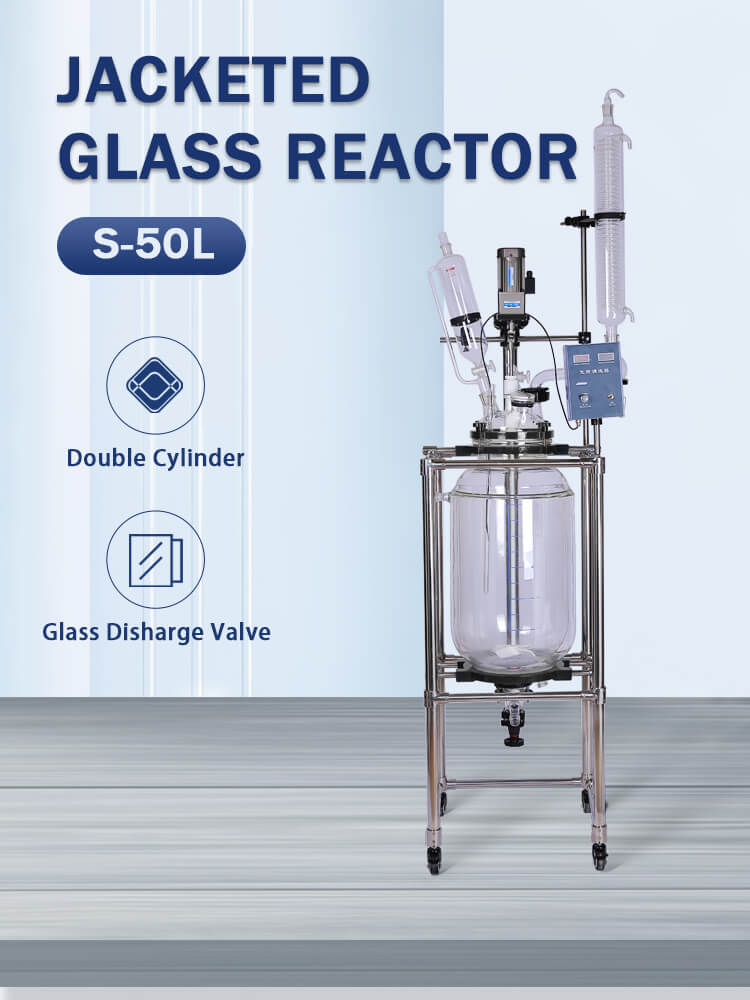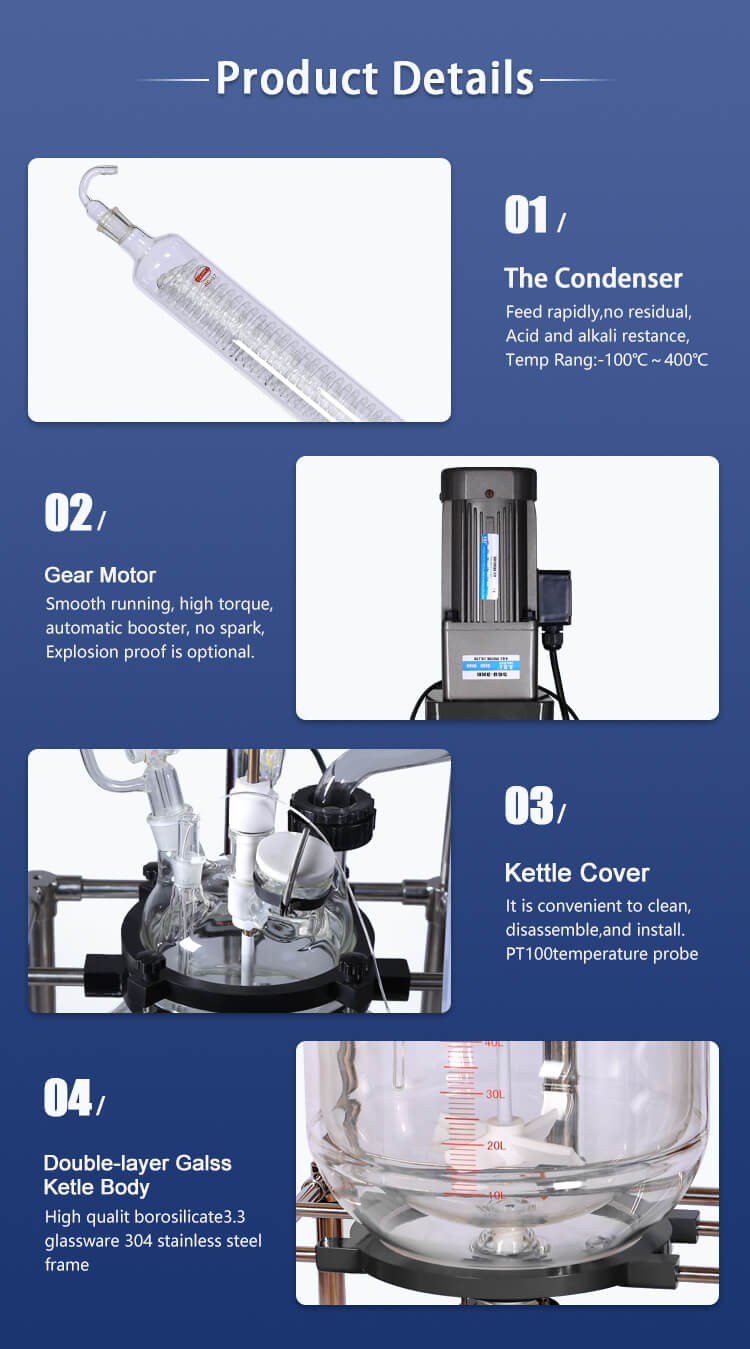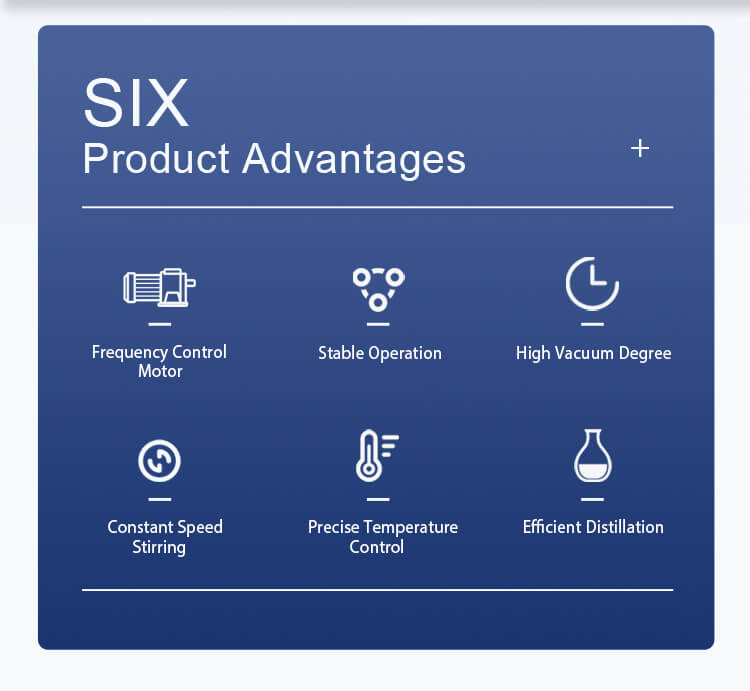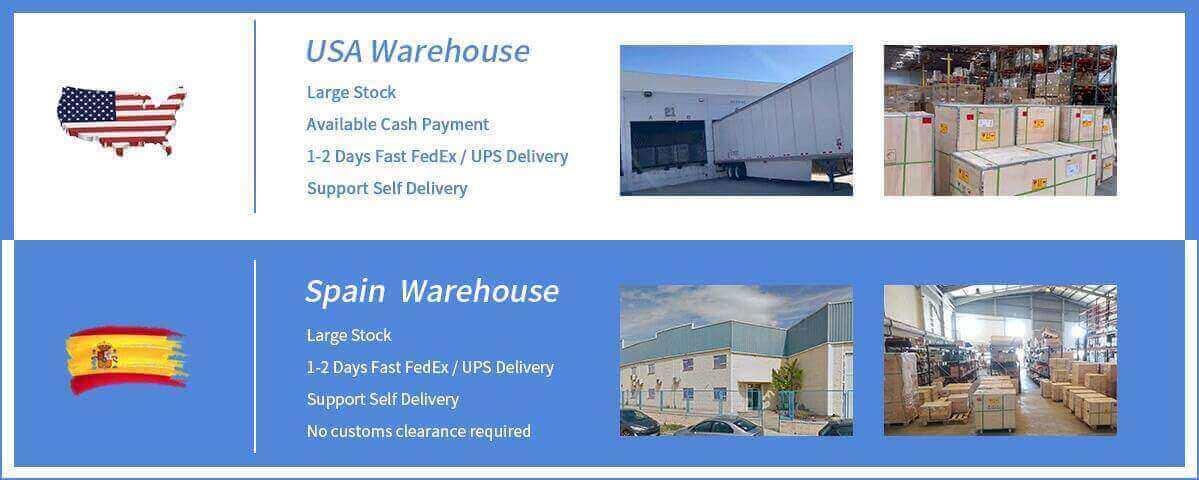The chemical laboratory glass reactor has a wide range of uses and is a commonly used biochemical instrument in the industry. Therefore, it is widely used in modern fine chemicals, scientific research experiments, biopharmaceuticals, colleges and universities, etc. ideal equipment. Our company's chemical laboratory glass reactor has guaranteed quality, moderate price, large inventory without delaying delivery, strict packaging, and sound after-sales service.

As a standing instrument in the laboratory for sulfuration, nitration, hydrogenation, alkylation, polymerization, condensation and other reaction experiments, glass reactors in chemical laboratories have their own advantages. The glass reactor in the chemical laboratory adopts a double-layer glass design. High-temperature and low-temperature liquids can be placed in the middle of the interlayer to provide a reaction temperature for the experimental materials inside the kettle body, and it will not pollute the materials. The overall sealing is good, and it can carry out stirring reaction work under negative pressure conditions. It is an ideal equipment for biopharmaceuticals, fine chemicals and new material synthesis. Because it is a high-precision equipment, the usual use and maintenance methods are very important. Today Jordan will share with you the correct use and characteristics of the chemical laboratory glass reactor produced by ZZKD.
How to use chemical laboratory glass reactor:
1. Check whether the power supply voltage is consistent with the voltage required on the machine nameplate.
2. Slowly feed solid or liquid materials into the kettle through the feeding port.
3. Adjust the set speed and start the stirring motor.
4. According to the needs of the reaction, turn on the supporting vacuum device to pump the inside of the 5L glass reactor to the required pressure state.
5. According to the reaction needs, turn on the supporting heating (refrigeration) circulation device to meet the temperature control requirements.
6. After the reaction is completed, turn off the temperature-controlled heating or cooling function according to the actual situation. When the temperature of the material in the kettle is close to room temperature, turn off the circulation device.
Note: After the temperature-controlled product circulation device is closed, the valve in the circulation pipeline cannot be closed; in order to avoid the glass parts being broken due to thermal expansion and contraction of the liquid.
7. Close the vacuum acquisition device.
8. Change the speed setting value to the minimum value and stop stirring.
9. Turn off the power of the controller.
10. Discharge from the discharge port of the discharge valve. After discharging, please remove the discharge valve in time, and carefully clean the discharge valve and discharge port.
11. Reinstall the discharge valve.
Tip: When discharging, turn the black knob at the lower end of the discharging valve counterclockwise. After cleaning the glass device, please use a clean soft cloth to wipe off the attached liquid inside and outside the device to avoid contamination.
Following Jordan to read the above content, do you know how to operate the glass reactor in the chemical laboratory, so as to avoid making mistakes during operation and causing damage to the instrument.

Features of chemical laboratory glass reactor:
The chemical laboratory glass reactor is characterized by variable frequency speed regulation, AC induction motor, constant speed, no brush, no spark, safe and stable, and can work continuously. The whole set of glass instruments is made of high borosilicate glass, which has good chemical and physical properties. The glass interlayer interface is connected to hot oil and circulated, which can be used for heating reaction. It can react at room temperature, and the reflected heat can be quickly taken away by tap water.

1. It is sealed with PTFE material and special rubber composite sealing ring, which can resist various solvents and maintain high vacuum, which is very convenient to use.
2. Condenser to ensure high recovery rate.
3. Standardized connection method, easy to disassemble.
4. Equipped with a discharge switch, it is very fast to recover the solvent.
5. Equipped with a vacuum gauge, the working vacuum can be adjusted for low boiling point materials.
6. Reasonable structure and exquisite materials. The whole machine is made of stainless steel, aluminum alloy and new synthetic materials, which have the advantages of anti-corrosion, anti-rust and resistance to various solvents.
7. The glass parts are all made of high temperature resistant borosilicate glass material, which has good physical and chemical properties.
8. The electrical components are carefully selected, and all the main components are imported original parts.
With an excellent product, the work will be more convenient. Of course, a good product also needs to know the precautions in normal times in order to prolong its service life and work more efficiently. Next, Jordan will share with you the precautions for the chemical laboratory glass reactor produced by ZZKD.
Precautions for chemical laboratory glass reactor:
1. Pay attention to heat preservation. It is understood that due to the small thickness of the interlayer in the middle of the glass reactor in the chemical laboratory, the thermal insulation performance is poor. In the process of using high temperature and low temperature, users need to use insulation materials to protect the kettle body.
At the same time, the user needs to wrap the body of the reactor and the liquid-conducting pipe with thermal insulation materials, and pay attention to the thickness of the thermal insulation layer to ensure a good thermal insulation effect.
2. Selection of temperature control medium. Generally speaking, users will choose temperature control media with different properties as the heat transmission medium for the reaction according to the required reaction temperature. Choose ice ethanol bath for low temperature, water bath for normal temperature, and oil bath for high temperature.
It is recommended that when using low temperature or high temperature, pay attention to choose the appropriate medium, the key is the viscosity. If the viscosity is too high, the circulation pump may not be able to carry it, and the circulation effect of the medium is not good, and the required temperature control effect cannot be achieved. If the high-power circulation pump is replaced hastily, the pressure of the pressurized medium is too high, and the inner lining of the glass reactor in the chemical laboratory is easily damaged, and the reactor is broken. Usually manufacturers will choose the corresponding heating medium according to their own products.
3. The storage location should be reasonable. The glass reactor in the chemical laboratory is used as a reaction amplification test device. The volume is usually 50-150L, and the volume can be customized in specific cases. Therefore, the scale of the test cannot be underestimated. Since the kettle body is made of glass, the stainless steel is the bracket and the legs are casters, the storage location needs to be carefully selected.
As far as the storage conditions are concerned, although the casters can be fixed with foot buckles, the stability is not strong. Therefore, the user should pay attention to choose a flat place to lay it flat during storage, and keep the mechanical stirring center consistent with the reactor, otherwise it will easily shake and become unstable, causing safety accidents. In addition, it must be placed in a well-ventilated place.
4. Precautions for feeding. Because the chemical laboratory glass reactor is an independent reaction shelf, and the reserved feeding port is small, the feeding process is more difficult.
In this regard, it is suggested that solid reagents can be made into solutions and added to the kettle, and liquid reagents can be pumped into the kettle through a matching water pump or oil pump. In particular, adding the reaction material into the reaction kettle through a constant pressure dropping funnel or a commonly used dropping funnel requires a corresponding mobile ladder so that the staff can add the test material.
The above content is the detailed situation of the ZZKD chemical laboratory glass reactor introduced by Jordan. I hope you can provide some help when you choose to buy the chemical laboratory glass reactor and encounter problems when using the chemical laboratory glass reactor.
ZZKD Machinery Instrument Equipment Co., Ltd. is a comprehensive manufacturer specializing in R&D, production, sales, laboratories, biochemical and pharmaceutical equipment, especially transevaporators, glass reactors, vacuum pumps, etc. 13 years of production and export experience and a series of ISO9001 and CE certificates, with warehouses in the United States, Spain and Thailand.

A good after-sales service
1. 24-hour online customer service to provide reasonable solutions.
2. Factory direct sales, fast arrival, 1-2 days from warehouse.
3. Video communication to guide problems that arise during use.
4. Professional after-sales department, after-sales return visit, maintenance service.
If you want to know about our products, or want to buy our equipment, please feel free to contact us, ZZKD will provide you with the best price for chemical laboratory glass reactor.





